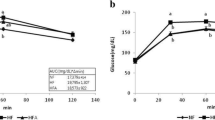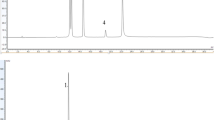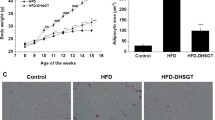Abstract
Obesity and overweight are associated with atherosclerosis, fatty liver, hyperlipemia, diabetes mellitus, and various types of cancer. The global prevalence of overweight and obesity has reached epidemic proportions. Here, we investigated the effect of Tamarindus indica pulp aqueous extract (TIE) in diet-induced obese Sprague–Dawley rats. The animals were divided into five groups and labeled as follows: the normal control (NC) group received normal diet; the positive control (PC) group received high-fat diet; and the TIE 5, 25, and 50 groups, after the induction of obesity via a high-fat diet, received TIE at 5, 25, or 50 mg/kg orally for 10 weeks. It was observed that TIE decreased the levels of plasma total cholesterol, low-density lipoprotein (LDL), and triglyceride, and increased high-density lipoprotein (HDL), with the concomitant reduction of body weight. Moreover, TIE decreased plasma leptin and reduced fatty acid synthase (FAS) activity and enhanced the efficiency of the antioxidant defense system. TIE exhibits antiobesity effects, as indicated by a significant reduction in adipose tissue weights, as well as lowering the degree of hepatic steatosis in the obesity-induced rats. The extract possesses hepatoprotective activity, as it reversed the plasma liver enzymes level elevation prior to the high-fat diet. In conclusion, TIE improved obesity-related parameters in blood, liver, and adipose tissue in a rat model and suppressed obesity induced by a high-fat diet, possibly by regulating lipid metabolism and lowering plasma leptin and FAS levels. A dose-dependant effect of TIE is detected, where TIE at 50 mg/kg showed the most prominent effect, followed by TIE at 25 mg/kg and, subsequently, 5 mg/kg.

Similar content being viewed by others
References
Fried M, Hainer V, Basdevant A, Buchwald H, Dietel M, Finer N, Greve JW, Horber F, Mathus-Vliegen E, Scopinaro N, Steffen R, Tsigos C, Weiner R, Widhalm K (2008) Interdisciplinary European guidelines on surgery for severe obesity. Rozhl Chir 87:468–476
Pagotto U, Vanuzzo D, Vicennati V, Pasquali R (2008) Pharmacological therapy of obesity. G Ital Cardiol (Rome) 9:83S–93S
Marović D (2008) Elevated body mass index and fatty liver. Srp Arh Celok Lek 136:122–125
Artham SM, Lavie CJ, Milani RV, Ventura HO (2008) The obesity paradox: impact of obesity on the prevalence and prognosis of cardiovascular diseases. Postgrad Med 120:34–41
Kim CH, Youn JH, Park JY, Hong SK, Park KS, Park SW, Suh KI, Lee KU (2000) Effects of high-fat diet and exercise training on intracellular glucose metabolism in rats. Am J Physiol Endocrinol Metab 278:E977–E984
Xu RY, Wan YP, Tang QY, Wu J, Cai W (2008) The effects of high fat on central appetite genes in Wistar rats: a microarray analysis. Clin Chim Acta 397:96–100
World Health Organization (WHO) (2000) Obesity: preventing and managing the global epidemic. Report of a WHO consultation. World Health Organ Tech Rep Ser 8944:i–xii, 1–253
Mohammad Nor NS, Khor GL, Shahar S, Kee CC, Haniff J, Appannah G, Rasat R, Wong NF, Zainuddin AA, Ab Rahman J, Abd Talib R, Yusoff AF (2008) The Third National Health and Morbidity Survey (NHMS III) 2006: nutritional status of adults aged 18 years and above. Malays J Nutr 14:1–87
Wadden TA (1993) Treatment of obesity by moderate and severe caloric restriction. Results of clinical research trials. Ann Intern Med 119:688–693
Snow V, Barry P, Fitterman N, Qaseem A, Weiss K; Clinical Efficacy Assessment Subcommittee of the American College of Physicians (2005) Pharmacologic and surgical management of obesity in primary care: a clinical practice guideline from the American College of Physicians. Ann Intern Med 142:525–531
Oben JE, Ngondi JL, Momo CN, Agbor GA, Sobgui CS (2008) The use of a Cissus quadrangularis/Irvingia gabonensis combination in the management of weight loss: a double-blind placebo-controlled study. Lipids Health Dis 7:12
Chrubasik C, Maier T, Dawid C, Torda T, Schieber A, Hofmann T, Chrubasik S (2008) An observational study and quantification of the actives in a supplement with Sambucus nigra and Asparagus officinalis used for weight reduction. Phytother Res 22:913–918
Roongpisuthipong C, Kantawan R, Roongpisuthipong W (2007) Reduction of adipose tissue and body weight: effect of water soluble calcium hydroxycitrate in Garcinia atroviridis on the short term treatment of obese women in Thailand. Asia Pac J Clin Nutr 16:25–29
Ignjatovic V, Ogru E, Heffernan M, Libinaki R, Lim Y, Ng F (2000) Studies on the use of “slimax”, a Chinese herbal mixture, in the treatment of human obesity. Pharm Biol 38:30–35
Feungchan S, Yimsawat T, Chindaprasert S, Kitpowsong P (1996) Tamarind (Tamarindus indica L.) plant genetic resources in Thailand. Thai J Agric Sci (Special issue) 1:1–11
Khairunnuur FA, Zulkhairi A, Azrina A, Mohamad Aris MM, Khairullizam S, Zamree MS, Mohd Shahidan MM (2009) Nutritional composition, in vitro antioxidant activity and Artemia salina L. lethality of pulp and seed of Tamarindus indica L. extracts. Malays J Nutr 15:65–75
Shivshankar P, Shyamala Devi CS (2004) Evaluation of co-stimulatory effects of Tamarindus indica L. on MNU-induced colonic cell proliferation. Food Chem Toxicol 42:1237–1244
Martinello F, Soares SM, Franco JJ, Santos AC, Sugohara A, Garcia SB, Curti C, Uyemura SA (2006) Hypolipemic and antioxidant activities from Tamarindus indica L. pulp fruit extract in hypercholesterolemic hamsters. Food Chem Toxicol 44:810–818
Luengthanaphol S, Mongkholkhajornsilp D, Douglas S, Douglas PL, Pengsopa L, Pongamphai S (2004) Extraction of antioxidants from sweet Thai tamarind seed coat—preliminary experiments. J Food Eng 63:247–252
Levin BE, Dunn-Meynell AA (2002) Defense of body weight depends on dietary composition and palatability in rats with diet-induced obesity. Am J Physiol Regul Integr Comp Physiol 282:R46–R54
Bolkent S, Yanardag R, Karabulut-Bulan O, Yesilyaprak B (2005) Protective role of Melissa officinalis L. extract on liver of hyperlipidemic rats: a morphological and biochemical study. J Ethnopharmacol 99:391–398
Kingsley GR (1942) The direct biuret method for the determination of serum proteins as applied to photoelectric and visual colorimetry. J Lab Clin Med 27:840–845
Brunt EM, Janney CG, Di Bisceglie AM, Neuschwander-Tetri BA, Bacon BR (1999) Nonalcoholic steatohepatitis: a proposal for grading and staging the histological lesions. Am J Gastroenterol 94:2467–2474
Iwashita S, Tanida M, Terui N, Ootsuka Y, Shu M, Kang D, Suzuki M (2002) Direct measurement of renal sympathetic nervous activity in high-fat diet-related hypertensive rats. Life Sci 71:537–546
Neyrinck AM, Bindels LB, De Backer F, Pachikian BD, Cani PD, Delzenne NM (2009) Dietary supplementation with chitosan derived from mushrooms changes adipocytokine profile in diet-induced obese mice, a phenomenon linked to its lipid-lowering action. Int Immunopharmacol 9:767–773
Jindal V, Dhingra D, Sharma S, Parle M, Harna RK (2011) Hypolipidemic and weight reducing activity of the ethanolic extract of Tamarindus indica fruit pulp in cafeteria diet- and sulpiride-induced obese rats. J Pharmacol Pharmacother 2:80–84
Wang Y, Deng M, Zhang SY, Zhou ZK, Tian WX (2008) Parasitic loranthus from Loranthaceae rather than Viscaceae potently inhibits fatty acid synthase and reduces body weight in mice. J Ethnopharmacol 118:473–478
Lamien-Meda A, Lamien CE, Compaoré MM, Meda RN, Kiendrebeogo M, Zeba B, Millogo JF, Nacoulma OG (2008) Polyphenol content and antioxidant activity of fourteen wild edible fruits from Burkina Faso. Molecules 13:581–594
Wang Y, Zhang SY, Ma XF, Tian WX (2006) Potent inhibition of fatty acid synthase by parasitic loranthus [Taxillus chinensis (dc.) Danser] and its constituent avicularin. J Enzyme Inhib Med Chem 21:87–93
Staiger H, Häring HU (2005) Adipocytokines: fat-derived humoral mediators of metabolic homeostasis. Exp Clin Endocrinol Diabetes 113:67–79
Rosenbaum M, Sy M, Pavlovich K, Leibel RL, Hirsch J (2008) Leptin reverses weight loss-induced changes in regional neural activity responses to visual food stimuli. J Clin Invest 118:2583–2591
Stockhorst U, de Fries D, Steingrueber HJ, Scherbaum WA (2004) Insulin and the CNS: effects on food intake, memory, and endocrine parameters and the role of intranasal insulin administration in humans. Physiol Behav 83:47–54
Goldenberg N, Glueck C (2009) Efficacy, effectiveness and real life goal attainment of statins in managing cardiovascular risk. Vasc Health Risk Manag 5:369–376
Tan BK, Tan CH, Pushparaj PN (2005) Anti-diabetic activity of the semi-purified fractions of Averrhoa bilimbi in high fat diet fed-streptozotocin-induced diabetic rats. Life Sci 76:2827–2839
Chan PT, Fong WP, Cheung YL, Huang Y, Ho WKK, Chen ZY (1999) Jasmine green tea epicatechins are hypolipidemic in hamsters (Mesocricetus auratus) fed a high fat diet. J Nutr 129:1094–1101
Crespy V, Williamson G (2004) A review of the health effects of green tea catechins in in vivo animal models. J Nutr 134:3431S–3440S
Reddy JK, Rao MS (2006) Lipid metabolism and liver inflammation. II. Fatty liver disease and fatty acid oxidation. Am J Physiol Gastrointest Liver Physiol 290:G852–G858
Conková E, Laciaková A, Pástorová B, Seidel H, Kovác G (2001) The effect of zearalenone on some enzymatic parameters in rabbits. Toxicol Lett 121:145–149
Acknowledgments
The study was supported by Research University Grant Scheme (RUGS) Universiti Putra Malaysia grant number 91135. The authors wish to acknowledge the Anatomy Laboratory of Universiti Putra Malaysia for their facilities.
Conflict of interest
There is no conflict of interest to disclose.
Author information
Authors and Affiliations
Corresponding author
Rights and permissions
About this article
Cite this article
Azman, K.F., Amom, Z., Azlan, A. et al. Antiobesity effect of Tamarindus indica L. pulp aqueous extract in high-fat diet-induced obese rats. J Nat Med 66, 333–342 (2012). https://doi.org/10.1007/s11418-011-0597-8
Received:
Accepted:
Published:
Issue Date:
DOI: https://doi.org/10.1007/s11418-011-0597-8




